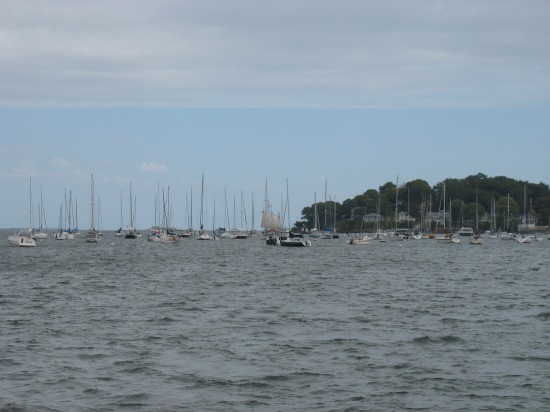New England roads, bless their spice-pickin’, shoe-cobblin’, trade-wind keelin’ hearts, take a traveler straight down to the knees a few times before they let up and simply remap your brain for navigating their terrain. Either that or you just stay down for the count.
These roads, someone once told me, bespeak aged connections to cow paths and backwoods trade routes. They circle utterly enchanting commons and roundies, but it’s important not to show up thinking you’ll follow a road map anywhere here. Narrow, winding, and gutsy, these roads are, and the marking of cross streets is wankered verboten. Street signs, even at intersections, carry one name: one: the more common two (everywhere else but rural Iowa) must be a colonial sacrilege of some sort that my years of study did not adequately prepare me to understand. You’d think you should be able to navigate your way around New England if you have a Ph.D. with one field straddling the long 18th century and kicking out both ends of it (late colonial Americas and U.S. in the world), no? No. You can drive on a main drag here for four miles and never know the name of it, because it simply isn’t marked on any of the cross streets.
Street names, too. They change them every few hundred feet. Even when the road doesn’t split or turn or do anything but lay itself out as straight ahead till morning as it can go? They give it a different name. Often. Google Maps handles that by constantly repeating the command, “Continue on x.” “Continue on y.” Continue on.
It’s a ruddy sight on earth. The road signage alone seems to intone, sermon-like from a tall pulpit, in the stentorian tones of Sinners before an Angry God: If you don’t know where you are, you probably shouldn’t be here. That used to buffalo me, so I over prepped my pre-mapping. Collected every last step of every planned jaunt, down to the distance between one turn and the next. This is a terrible idea and a worse practice. The more prepped you are, the more lost you can get, and the quicker you’ll do it, too. There is a better way. It involves thinking like a cow.
I adore New England. Everything about it. Even the fact that it is packed with more people than you can shake a stick at. But when I get behind the wheel of a car to go someplace entirely new—and especially when I’ve been away for too long—if I forget the insights of the cow path and start thinking like a person? I will get lost. But when I remember to look up and around and smell the air and follow my instincts in the general direction of where I’m headed? I get where I’m going. Usually by a preferred route to boot (though I only learn that much later, which makes it akin to getting happy news twice).
You have to aim somewhere and then amble, peaceably, chewing a cud and not overwrought at the world, genially following the tail of the car ahead and taking direction off the side streets: I’ve been on this road now for 4.2 miles and there, I just passed a Lowell Ct sign. So yes, this must be Lowell Road now. Oh, that’s Andover Ct. Must’ve transformed itself from Lowell to Andover somewhere near that blue colonial with the metal-gray roof. Wonder if there’s a watering hole anywhere close? Ambling thus makes me thirsty. Oh yes. Of course. Dunkin Donuts. There’s one roughly every block in all directions. Sometimes two. Can’t use them to navigate by, because they nearly all look alike, but you can fuel up for the trip everywhere. Plus you can talk to Yankees while you do it.
These people are some of the friendliest I have ever met. Most of them don’t know what|from on directions (they can be two blocks from where I’m heading and have no idea what I’m talking about, though my accent and historical leanings could be skewing that sample; and if I were looking for a baseball or football venue, I’m fairly sure I could get detailed instructions). Those who know are happy to help: I’ve had people cross busy streets and come out from behind lunch counters with people waiting in the line to help me when they see that I’m asking someone who doesn’t know.
New England is about community. It would have to be, given how many people are here and how long that’s been so. It’s also about land and sea. And therein may lie the crux, a better explanation than colonial cow paths and jeremiads to boot: this culture is deeply rooted in navigating blue water with nary a spit of land within beckoning or seeing distance, no matter the mood of the skies and winds, and, as if that isn’t enough, they are skilled in bringing vessels safely to harbor undeterred by the perils of any shoals because they relied on pilots and instincts and sea charts and advice shared from one mariner to another for generations. Cross-directional road signs? Who needs those?
~

